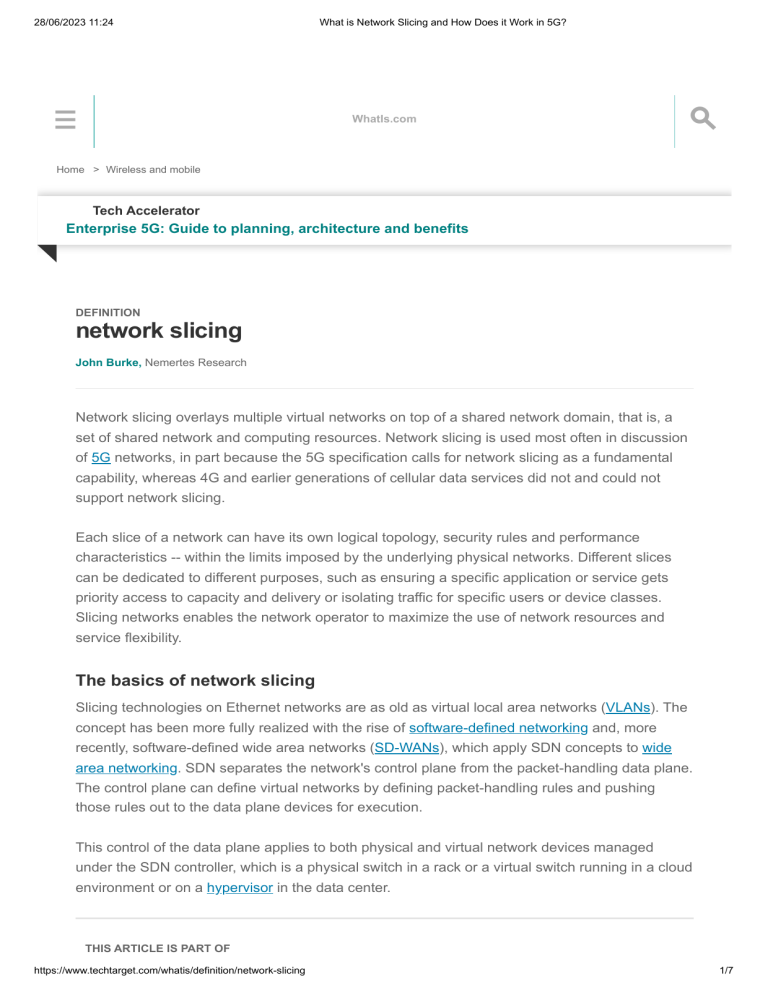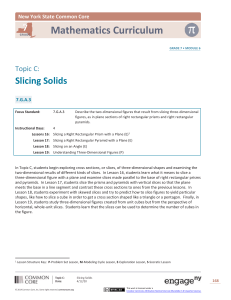
28/06/2023 11:24 9 What is Network Slicing and How Does it Work in 5G? WhatIs.com g Home > Wireless and mobile Tech Accelerator Enterprise 5G: Guide to planning, architecture and benefits DEFINITION network slicing John Burke, Nemertes Research Network slicing overlays multiple virtual networks on top of a shared network domain, that is, a set of shared network and computing resources. Network slicing is used most often in discussion of 5G networks, in part because the 5G specification calls for network slicing as a fundamental capability, whereas 4G and earlier generations of cellular data services did not and could not support network slicing. Each slice of a network can have its own logical topology, security rules and performance characteristics -- within the limits imposed by the underlying physical networks. Different slices can be dedicated to different purposes, such as ensuring a specific application or service gets priority access to capacity and delivery or isolating traffic for specific users or device classes. Slicing networks enables the network operator to maximize the use of network resources and service flexibility. The basics of network slicing Slicing technologies on Ethernet networks are as old as virtual local area networks (VLANs). The concept has been more fully realized with the rise of software-defined networking and, more recently, software-defined wide area networks (SD-WANs), which apply SDN concepts to wide area networking. SDN separates the network's control plane from the packet-handling data plane. The control plane can define virtual networks by defining packet-handling rules and pushing those rules out to the data plane devices for execution. This control of the data plane applies to both physical and virtual network devices managed under the SDN controller, which is a physical switch in a rack or a virtual switch running in a cloud environment or on a hypervisor in the data center. THIS ARTICLE IS PART OF https://www.techtarget.com/whatis/definition/network-slicing 1/7 28/06/2023 11:24 What is Network Slicing and How Does it Work in 5G? Enterprise 5G: Guide to planning, architecture and benefits Which also includes: 5G vs. 4G: Learn the key differences between them What are the features and benefits of 5G technology? Top 5G limitations and challenges for businesses For some use cases, the network operator will want or need to dedicate network infrastructure to a specific slice of the network, like assigning a virtual firewall to a specific virtual network instead of using a shared firewall. In some cases, this step is done to meet specific customer compliance or network security requirements. In other cases, network managers will look to improve network performance or minimize the overhead of providing services. For example, network operators could deploy an instance of a low-cost or free firewall instead of paying for a more expensive one. The flip side of slicing is aggregation. An SDN approach does enable aggregation of physical connectivity -- the melding of multiple physical connections into a switch, for example -- with the resulting pooled capacity then made available for slicing. How does network slicing work in 5G? Network slicing is a key feature of 5G. Slice implementation applies the same principles of virtualization across the entire provider network architecture. These principles include radio access networks and the supporting backhaul and carrier core networks that underlie 5G, including associated data center resources. Slicing enables service providers to create a variety of network slice architectures that deliver meaningful guarantees to customers regarding, say, a minimum amount of throughput for their connections or priority delivery of packets from specific types of devices or applications. https://www.techtarget.com/whatis/definition/network-slicing 2/7 28/06/2023 11:24 What is Network Slicing and How Does it Work in 5G? A 5G network operator can physically segregate traffic on different radio networks, slice a single network, or combine the capacity of multiple networks and slice the pooled resources. This enables 5G network operators to choose the characteristics needed to support their target levels of spectrum efficiency, traffic capacity and connection density, which is how many devices can connect from a given space. 5G service types -- high-level categories of network slice architecture -- that use slicing for differential handling of traffic include the following: Enhanced Mobile Broadband, or eMBB, provides mobile data access in one of three ways: to dense collections of users, to highly mobile users and to users spread over wide areas. It relies on features such as large arrays of multiple input, multiple output (MIMO) antennas and the combination of spectra starting with conventional 4G wavelengths and stretching into the millimeter band. Massive Machine-Type Communications, or mMTC, services are built to serve massive numbers of devices in a small area with the expectation that they generate little data (about tens of bytes per second) and can tolerate high latency (up to 10 seconds on a round trip). Further, the specifications require that sending and receiving data requires little power so that devices can have long battery lives. On a related note, the 5G New Radio spec calls for support of 1 million devices in 1 square kilometer. Ultrareliable low-latency communications, or URLLC, uses 5G to deliver secure communications with latencies of 1 millisecond (ms) and high reliability with low, or even zero, packet loss. It is achieved through a combination of physical device optimizations on MIMO antenna assemblies, simultaneous manipulation of multiple frequency bands, packet coding and processing techniques, and optimized signal handling. https://www.techtarget.com/whatis/definition/network-slicing 3/7 28/06/2023 11:24 What is Network Slicing and How Does it Work in 5G? Benefits of network slicing For service providers, slicing in combination with virtual network functions is the key to "just right" services. Namely, on a base of generic wireless infrastructure and general-purpose compute and storage resources, service providers provision only as much capacity for specialized services as is required to meet the needs of paying customers. Using built-in capabilities to slice capacity and using all virtual service platforms also mean that even complex and unique customer environments can be spun up in a short time. For service providers, more ability to customize inexpensively provides the following benefits: Create new revenue opportunities by lowering the barriers to trying out new service offerings. After specialized hardware is designed for a job, it does not need to be bought and then fully depreciate. Increase flexibility by enabling more kinds of services to be offered simultaneously, since they don't require dedicated and specialized hardware. Easier scaling is possible since all the physical infrastructure is generic. Increased return on investment is also likely since the ability to constantly try new things enables a maximum use of resources. https://www.techtarget.com/whatis/definition/network-slicing 4/7 28/06/2023 11:24 What is Network Slicing and How Does it Work in 5G? Network slicing use cases Network slicing supports use cases that focus on performance, capacity and security. Many use cases involve emerging internet of things business models. Some network slicing use cases include the following: Real-time performance. A company depending on a 5G network for autonomous vehicle management might contract for a mobile network slice with latencies under 5 ms and stringent guarantees of packet delivery on the minimum throughput required to ensure responsive control. The provider would use URLLC functionality to guarantee the slice on the lowest-latency equipment and paths between vehicles and cloud or edge resources and reserve enough capacity to meet the throughput target. Capacity. For a security monitoring system in a large auditorium, latency may not matter. But the security company may want to buy guaranteed delivery of the camera data. In other words, the company would want its traffic to get 1.5 megabits per second of throughput per camera with no packets dropped, ever. The provider might aggregate multiple connectivity and processing device options to meet the needs of this slice. Security. For a human health monitoring system in a metropolitan area, a hospital might want to isolate all traffic to and from pacemakers. This would minimize the risk of a leak of customer data and the threat of compromise of the control channel -- so it would require a slice with single-user virtual resources. Business and enterprise possibilities Enterprises and smaller businesses find slicing an attractive option on their own networks, for both performance and security management, hence the rapid rise of SD-WAN and network segmentation technologies. As 5G networks continue to mature and spread, slicing increases the utility of a wireless WAN (WWAN) and an enterprise wireless LAN (WLAN): WWAN. Before 5G, small branch offices have depended on 4G Long-Term Evolution as backup connectivity in case their primary wired connections fail and, less often, used it as primary connectivity. 5G, with higher speeds and slicing, will accelerate the adoption of the WWAN model and increase use as primary or sole connectivity, since companies will get meaningful service-level agreements that reflect the carriers' ability to control capacities and performance. WLAN. Those same capabilities for greater control will increase the appeal of 5G as a replacement for private Wi-Fi-based WLANs. Traditionally, enterprises provision and manage a private network and implement remote and mobile network access technologies. With 5G and slicing, many will instead use 5G only. Users have the same experience independent of location thanks to mobile broadband service via a private network slice integrated to the company WAN. This was last updated in May 2022 ∙∙ ∙ m Continue Reading About network slicing What is network slicing? 5G wireless technology influences telecommunication's future 5G network slicing security benefits IoT, mobile https://www.techtarget.com/whatis/definition/network-slicing 5/7 28/06/2023 11:24 What is Network Slicing and How Does it Work in 5G? Related Terms Google Play Google Play, formerly known as Android Market, is the official online store for digital media distributed by Google. See complete definitionq hertz (Hz) Hertz (Hz) is the standard unit of frequency in the International System of Units (SI). See complete definitionq iPad The iPad is a touchscreen tablet PC made by Apple. See complete definitionq Word of the Day DEI Diversity, equity and inclusion is a term used to describe policies and programs that promote the representation and participation of different groups of individuals. Subscribe to the Word of the Day 20 Newest and Updated Terms Fréchet inception distance (FID) What is UCaaS? Unified communications as a service guide Occupational Safety and Health Administration (OSHA) daily stand-up meeting pseudocode What is public cloud? Everything you need to know What is patch management? Lifecycle, benefits and best practices git stash web development framework (WDF) WebAssembly internet of things device management (IoT device management) machine teaching multiprocessing automated machine learning (AutoML) meter per second (m/s) https://www.techtarget.com/whatis/definition/network-slicing 6/7 28/06/2023 11:24 What is Network Slicing and How Does it Work in 5G? milliampere-hour (mAh) hybrid flash array iPad lift and shift association rules NETWORKING SECURITY CIO HR SOFTWARE CUSTOMER EXPERIENCE Networking Nessus Nessus is a platform developed by Tenable that scans for security vulnerabilities in devices, applications, operating systems, ... logical network A logical network is a software-defined network topology or routing that is often different than the physical network. Browse by Topic Browse Resources About Us Meet The Editors Editorial Ethics Policy Events Media Kit Contact Us Corporate Site Advertisers Business Partners Reprints All Rights Reserved, Copyright 1999 - 2023, TechTarget Privacy Policy Do Not Sell or Share My Personal Information https://www.techtarget.com/whatis/definition/network-slicing 7/7



